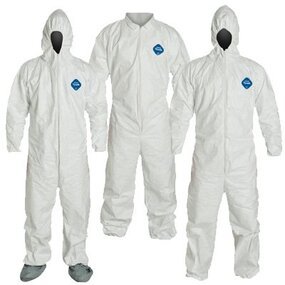 Let’s start with thinking about what the ideal PPE for Infectious Disease defense would look like. Imagine a personal force field that extends a few inches around the body, preventing anything in the environment from getting in other than clean, filtered air. Comic book heroine Sue Storm from the Fantastic Four had a force field as her superpower. Sadly, in the real world, such protection does not exist. Stepping away from that ideal protection for a moment, Infectious Disease PPE defends four priorities: the eyes, nose, mouth, and hands. The first three are collectively called the 'mucous membranes' and are direct infection sites. The hands are important since they are usually the most contaminated surfaces after time spent in an Intensive Care ward - and people touch their face a lot, including doctors and nurses. So here’s a test. If one had the ideal and invisible force field and was asked "how can we screw this up in the worst way(s) for use in Infectious Disease PPE?", what changes would one make? The answer would be: (a) remove facial protection for the mucous membranes, and (b) don’t protect the hands. This would produce … general-purpose coveralls! They protect NONE of those four priorities. ZERO! They are truly horrible for Infectious Disease defense. Yet these general-purpose coveralls are widely used in Infectious Disease hospitals. Why? Because they are sold each year by the tens of millions and used in countless applications such as painting, asbestos clean-up, oil spills, crime scene investigations, tank cleaning, food processing, industrial settings, etc. They are widely available, cheap (because of volume production), and represent the lowest common denominator of PPE. Is optimized Infectious Disease PPE much better than general-purpose coveralls? Miles better.
Let’s use a car analogy to show how tailored design and engineering matters. For everyday trips like going to the grocery store, driving Timmy to soccer practice, and hundreds of other errands, a general-purpose car like a Ford Taurus or Toyota Camry works wonderfully. In a race like the Indy 500 however, the general-purpose car cannot compete against a Formula One race car, which is designed, built, and honed to overcome unique and demanding engineering challenges. Using general-purpose coveralls as Infectious Disease PPE is like taking a Toyota Camry into the Indy 500. Yes, the Camry can finish the 500-mile race. But any real race car easily outperforms it. General-purpose coveralls are not designed or engineered to meet the unique demands of Infectious Disease defense: they offer no protection for all three mucous membranes, no aids to reduce self-contamination while doffing, they enable the two glove doffing conundrum (after removing the first glove…), they retain heat and lead to sweaty discomfort, and more. With substandard equipment, the driver does not matter in the Indy 500; Louis Hamilton driving a production Camry would lose every race against his peers driving F1 cars. Same with health care workers in Infectious Disease hospitals who are left to wear painting coveralls. What about the other off the shelf pieces of PPE that we add to general-purpose coveralls, like an N95 respirator and a face shield? This hodgepodge of disparate parts is like modifying a Ford Taurus with off the shelf parts from the local NAPA auto parts store. The Taurus fares a little better, but a real race car will outperform it – easily, and every time. Firefighters, police officers, military personnel, and Infectious Disease health care workers all risk their lives daily. All of them deserve our respect and gratitude for their courage. Only one profession wears painting coveralls. Comments are closed.
|
About
Will has been developing PPE for Infectious Disease defense since 2003. He's worked with PPE experts and health care workers everywhere from Toronto to Geneva, Atlanta's CDC, Singapore, Korea, Stanford U, Manhattan, Cleveland, countless hospitals, and a most memorable Panera Bread in Pittsburgh. Here are some lessons and stories from the journey. |
